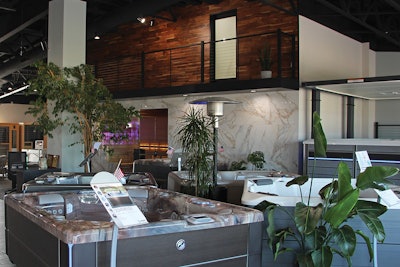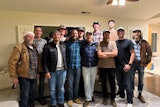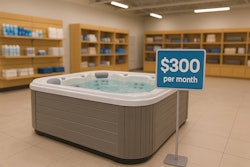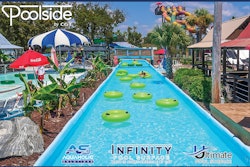
Ted Lawrence, retail specialist and vice president of Pro Sales at KIK/Biolab, posed a crucial question during his presentation "Maximize Revenue in Retail" at the 2023 AQUA Live Leadership Retreat: "What do consumers seek when they leave their homes, get into their cars, and embark on a shopping journey?"
It's an engaging and stimulating experience, he says, that appeals to the five senses: sight, touch, taste, smell and sound.
The five senses play a crucial role in creating a memorable and immersive retail environment. Pool and spa dealers can leverage sensory experiences to engage customers, enhance their shopping journey, and ultimately influence their purchasing decisions. Here's a breakdown of the importance of each sense in a retail setting.
1. SIGHT
Visual appeal is an important factor in drawing customers and crafting a positive initial impression. Lawrence, in his presentation, shared a critical insight — modern customers not only expect showrooms to be organized but also demand fresh, eye-catching displays. For the pool and spa dealer, one effective strategy for achieving this is through seasonal changeouts.
Lawrence advises, "Aim for a minimum of three seasonal changeouts annually." For those situated above the frost line, he suggests promoting pool opening kits in early spring. In summer, a 4th of July theme can tap into customers' patriotic sentiments. And end-of-year sales and holiday-themed showroom decorations can foster a joyful and festive atmosphere.
Showroom lighting can also set the right mood within the store and influence customer perception. "There's a Kelvin scale that starts around 1,000 and goes up to 10,000," says Lawrence. "The higher the number, the whiter the light will appear, which in turn, creates a sense of cleanliness. A doctor's office looks so sterile because they're running a 10,000 Kelvin light, whereas the apples in a grocery store look so red because they're running a 4,000 Kelvin light. When you're trying to highlight a high-end product, like a swim spa for example, you want to be running around a 4,000 Kelvin light in order to bring out the color. It's important to note that the higher you go in Kelvin, the cleaner you have to keep your showroom products."
In the contemporary era dominated by smartphones and widespread addiction to these devices, Lawrence also proposes integrating digital signage into showrooms. "A television or digital photo frame is a great way to get digital signage into your retail store," he says. "Consumers are attracted to screens. We're attracted to our cell phone screens, our television screens, any screen really, so why not include a screen with a video explaining how a product works or to promote a sale price?"
2. TOUCH
To appeal to touch, another key sense, Lawrence suggests that rather than consistently direct and control the sales process, let the customer explore your products independently.
"When you're showing a potential customer a hot tub, let them touch all the bells and whistles on it themselves," says Lawrence. "Let them figure out how it works. There's a reason why no one looks at the instruction manual of an iPhone. It's supposed to be intuitive. Manufacturers are spending tons of time and money to make products that are intuitive, so, let your customer figure out your products on their own. You should only be there to assist them if they need it."
To further involve customers, he proposes the incorporation of interactive displays into showrooms. Whether showcasing automation or controls, these displays provide consumers with a tangible experience. "Interactive displays are another element that consumers can see, feel, touch and interact with," he says. "The longer a customer stays in your retail store, the more likely they are to buy something from you. You need to get your products into their hands and let them drive the sales conversation."
 Peripheral retail products at Patio Pleasures (Sun Prairie, Wis.), such as umbrellas and lights, help to target customers' sense of sight, setting the scene for outdoor relaxation.
Peripheral retail products at Patio Pleasures (Sun Prairie, Wis.), such as umbrellas and lights, help to target customers' sense of sight, setting the scene for outdoor relaxation.
3. TASTE
According to Lawrence, the sense of taste is the most accessible. He suggests a simple yet impactful strategy — serving drinks, which incurs minimal costs but leaves a lasting impression on customers.
"There's immense value in providing drinks in your retail store; it's a gesture of courtesy," Lawrence emphasizes. To enhance the experience, he recommends making the drinks regional. "I work in Atlanta, Ga., so sweet tea is a big deal. If you work in the South like I do, brew your own sweet tea and serve it to your customers, and I promise you, this thoughtfulness will pay for itself in the long run. In the wintertime, serve hot chocolate. Always have a coffee station with something as simple as a Keurig with some K Cups. Appealing to your customer's taste should be simple and fun."
Beyond beverages, food is another effective way to tantalize customers' taste buds and open their wallets. "In the summertime, you should definitely be serving ice cream," says Lawrence. "Get a freezer display online, a few varieties of ice cream from the store, and there you go — you now have a treat for both children and adults alike. And customers, feeling obligated to finish their treat before leaving your store, are likely to spend more time and money."
To add a marketing touch, wrap your business name or company logo around the ice cream freezer, too.
4. SMELL
Seventy-five percent of memories are correlated back to scent. "Whether it's the smell of a cigar that reminds you of your grandfather's couch, or the smell of flowers that reminds you of your first girlfriend, our memories are connected to scent in some way," says Lawrence. "So it's really important to use this fact when setting up our retail stores."
But, while some people like the smell of chlorine, Lawrence would argue a whopping majority of your customers don't. How then, do you appeal to a customer's sense of smell when most hot tubs smell like nothing and most chemicals smell unappealing? Lawrence suggests diffusers. "Diffusers are relatively inexpensive and can make all the difference in what your showroom smells like."
To help lock down your scent, Lawrences recommends the company ScentAir, which will allow you to do scent sampling by sending you a little sample kit. They also have scentmasking technology that hides the smell of bad scents. "You are going to spend a little bit more money, but you can actually give them a customer's profile, and they will give you a recommendation on the type of scent, based upon the customer's demographic profile.
"And you should absolutely profile your customers — find out what they like to smell when they're using their pool or hot tub. Make sure you use the same scent all throughout your store and at all your locations, too. You want your customers thinking of your business whenever they smell the scent you choose to pump out into your showroom."
5. SOUND
In concluding his presentation, Lawrence shed light on the art of playing music in retail stores, emphasizing the need for careful planning regarding the type, timing, and volume to resonate with customers.
"Why are restaurants loud? The first reason has to do with finances. The louder the music and the environment, the more likely you are to leave. Restaurants have the opposite goal of retail stores; they want to turn over tables, whereas we want to keep customers in our showrooms for as long as possible. The second reason: If one of your senses is heightened — so in the case of a restaurant, sound would be heightened — then your other four senses will also become stimulated, so the food will actually taste better."
Using grocery stores as an example, he illustrated how the choice of music should align with the age demographics of customers at different times. Morning and daytime shoppers, typically older individuals, are treated to '60s music, while evenings and weekends cater to Generation X and Millennials with 2000s hits and a sprinkle of Disney tunes. "You need to incorporate this type of music profiling into your showroom so that you keep all your customers engaged at all times," he says.
Highlighting the importance of varying playlists and product demonstration videos on display screens, Lawrence cautions against looping music, which could annoy your employees. Drawing from a Starbucks encounter, he shared the negative impact of repetitive music on employee morale.
"If you put something on loop, your employees are going to go insane," says Lawrence. "You don't want to jeopardize your employees' senses in order to appeal to your customers — there always needs to be some sort of compromise."











































